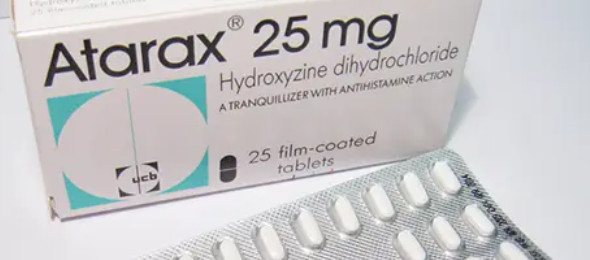
Indications
- Urticaria : 10 mg four times/day
- Dermographism : 10 to 25 mg daily to four times a day
- Cholinergic Urticaria: 10 to 50 mg taken 1 hour before exercise
- Bullous pemphigoid:10 to 50 mg every 4 hours to control itching
- Cercarial dermatitis :25 mg PO every 6 h as required for pruritus × 1 week.
- Lichen simplex chronicus:25–50 mg
- Psychogenic pruritus :50–75 mg daily
- Insomnia
- Pruritus.
- Sedation.
- Nail surgery : combination of hydroxyzine 25 mg the night before the operation with 0.5 mg lorazepam sublingually 1 h prior to surgery.
Mechanism of action
- It is a first-generation peripheral and central H1 histamine receptor blocker Because it acts centrally, it causes sedation.
Dosage
- 10- 50 mg qid.
Side effects
- COMMON: dry mouth, drowsiness, dizziness, ataxia, weakness, slurred speech, headache, agitation, bitter taste, nausea.
- RARE: wheezing, dyspnea, seizures, respiratory depression, tremor
Contraindications
- Hypersensitivity to drug/class.
- Prolonged QT interval.
- SC, intra-arterial, or IV administration.
- Asthma.
Interactions
- Increased central nervous system depression: opiates, propoxyphene, tramadol, antidepressants, antihistamines, barbiturates, benzodiazepines, central alpha-2 agonists, droperidol, dronabinol, ethanol, meperidine, meprobamate, metoclopramide, muscle relaxants, phenothiazines, promethazine.
- Increased anticholinergic activity: anticholinergics, central alpha-2 agonists, cyclopentolate/phenylephrine, dexmedetomide, disopyramide.
- Decreased efficacy of hydroxyzine: cholinergics.
- Caution recommended during concomitant use of drugs known to prolong QT interval including Class 1A (e.g., quinidine, procainamide) or Class III (e.g., amiodarone, sotalol) antiarrhythmics, certain antipsychotics (e.g., ziprasidone, iloperidone, clozapine, quetiapine, chlorpromazine), certain antidepressants (e.g., citalopram, fluoxetine), certain antibiotics (e.g., azithromycin, erythromycin, clarithromycin, gatifloxacin, moxifloxacin); and others (e.g., pentamidine, methadone, ondansetron, droperidol).
Pregnancy &Lactation
- Pregnancy category: Considered to be contraindicated in early (1st trimester) pregnancy until more human pregnancy data available.
- Limited experience in human pregnancy, either for drug itself or drugs in same class or with similar mechanisms of action, including 1st trimester, current limited data suggests that the drug does not represent a significant risk of developmental toxicity including growth restriction, structural anomalies, functional/behavioral deficits, or death at any time in pregnancy.
- Lactation: Excretion in milk unknown; use with caution
Precautions
- Hydroxyzine may cause CNS depression resulting in drowsiness; avoid driving or operating dangerous machinery.
- It may cause oversedation and confusion in elderly patients; start on lower doses and monitor closely.
- Hydroxyzine may rarely cause acute generalized exanthematous pustulosis (AGEP)
Drug Info
- Hydroxyzine is the most potent of the classical antihistamines.
- First-generation H1 antihistamines are relatively lipophilic, they generally cross the blood–brain barrier and cause signifcant sedation.
- In patients with liver disease, or in patients who are currently receiving CYP3A4 inhibitors such as erythromycin or ketoconazole, the plasma half-life may be greatly prolonged.
- Hydroxyzine has two ‘active metabolites’ which are second-generation antihistamines, namely cetirizine and levocetirizine.
#Hydroxyzine #Hydroxyzine indications